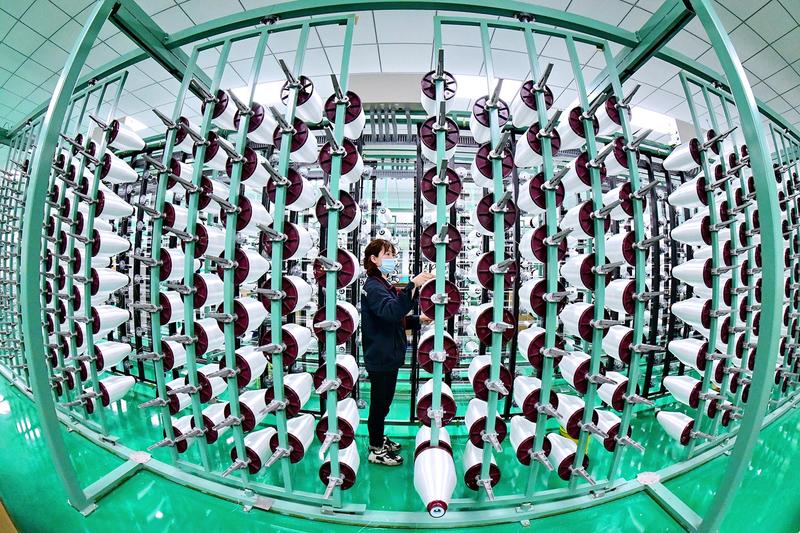Big help for upstream plays from rise in prices of energy and raw materials
 An employee works on the production line of a glass fiber-reinforced polymer producer in Ganzhou, Jiangxi province. (ZHU HAIPENG / FOR CHINA DAILY)
An employee works on the production line of a glass fiber-reinforced polymer producer in Ganzhou, Jiangxi province. (ZHU HAIPENG / FOR CHINA DAILY)
Profits of China's industrial firms rose 8.5 percent year-on-year in the first quarter, the National Bureau of Statistics said on Wednesday, suggesting a steady start for the industrial economy this year.
Experts said the steady growth was mainly aided by bigger profits reported by upstream companies from rising energy and raw material prices, while some midstream and downstream firms still face mounting pressure and difficulty.
They called for further steps to stabilize the overall economy amid downward pressure from COVID-19 outbreaks and a more complicated external environment, saying more efforts should be made to ensure smooth logistics services, stabilize industrial and supply chains, ease pressure on hard-hit enterprises and industries as well as increase financial support for small and medium-sized enterprises.
In the January-March period, industrial firms' bottom line growth rate was 3.8 percentage points lower than that in the fourth quarter of 2021, the NBS said.
Industrial firms' profits reached 1.96 trillion yuan ($300 billion) in the first three months, and the pace of profit growth quickened from a 5.0 percent gain reported in the first two months.
Zhu Hong, a senior NBS statistician, attributed the growth to effective government measures to cut taxes and fees and ease pressure on enterprises during the period.
During the January-March period, profits of mining firms grew 1.48 times. Profits in manufacturing fell 2.1 percent in the first quarter and bottom lines reported by power, heat, gas, water production and supply firms slumped 30.3 percent.
Zhu warned that industrial firms are facing multiple challenges from resurgent domestic COVID-19 cases and intensifying imported inflationary pressure, adding that more efforts should be made to ensure stable prices and supplies as well as smoother logistics services.
Zhou Maohua, an analyst at China Everbright Bank, attributed the large profits registered by upstream firms to expanding global demand and soaring energy and raw material prices, saying the slowdown in profits of some midstream and downstream firms is a combined result of a high-base effect from the previous year and rising commodity prices.
Although pressure from resurgent domestic COVID-19 cases may cloud the outlook for a short period, China is capable of maintaining steady growth for the whole year with the help of solid government measures to control the pandemic and support hard-hit enterprises, Zhou said.
Li Qilin, chief economist at Shanghai-listed Hongta Securities, warned of mounting pressure from domestic COVID-19 cases and imported inflationary pressure.
Citing the government's recent moves to ensure stable prices and spur consumption, Li expects the measures will help ease pressure on rising costs for enterprises, which may help support profit growth for midstream and downstream enterprises.
A number of banks lowered their deposit rates and interest rates of large-denomination Certificates of Deposit recently. Industrial and Commercial Bank of China Ltd, the country's largest State-owned commercial lender by assets, cut its three-year deposit rate by 10 basis points to 3.15 percent and two-year deposit rate by 10 basis points to 2.5 percent. China Merchants Bank Co Ltd, a national joint-stock commercial lender, lowered the interest rate of its three-year large-denomination CDs by 45 basis points to 2.9 percent.
These moves-combined with recent regulatory efforts to incentivize small and medium-sized banks to reduce the upper limit on the floating range of deposit rates by around 10 basis points-show that banks are taking multiple paths to cut the cost of deposits in order to provide more low-cost funding for the real economy, analysts said.
Reductions in the cost of deposits will lead to a decline in lending rates, thus lowering financing costs for the real economy, said a report released by CSC Financial Co Ltd.
By encouraging small and medium-sized banks to lower the ceiling on the floating range of deposit rates and linking the adjustment to macro-prudential assessments, regulators will reduce pressure on banks to compete for deposits and help them improve net interest margins, said Zheshang Securities Co Ltd.
Contact the writers at ouyangshijia@chinadaily.com.cn


